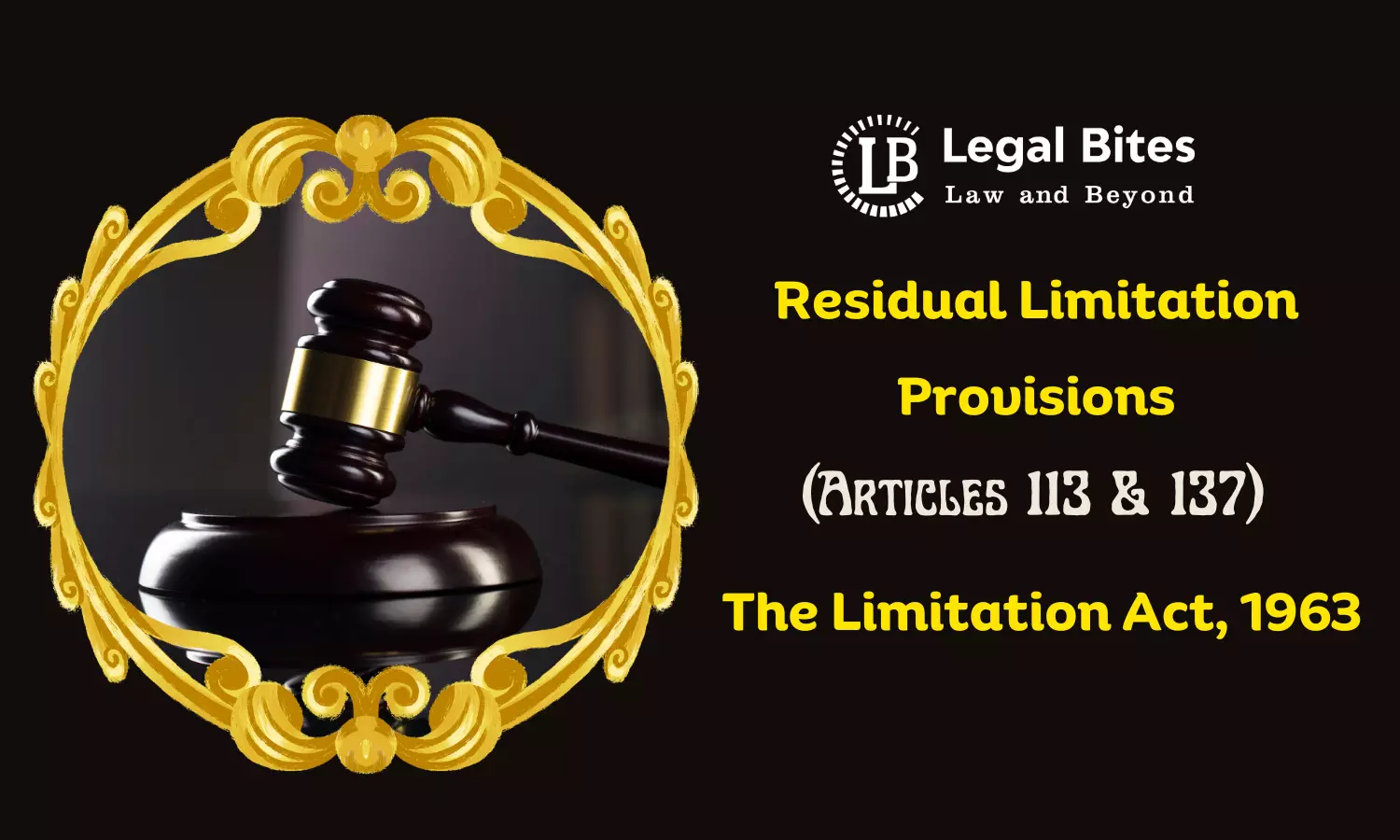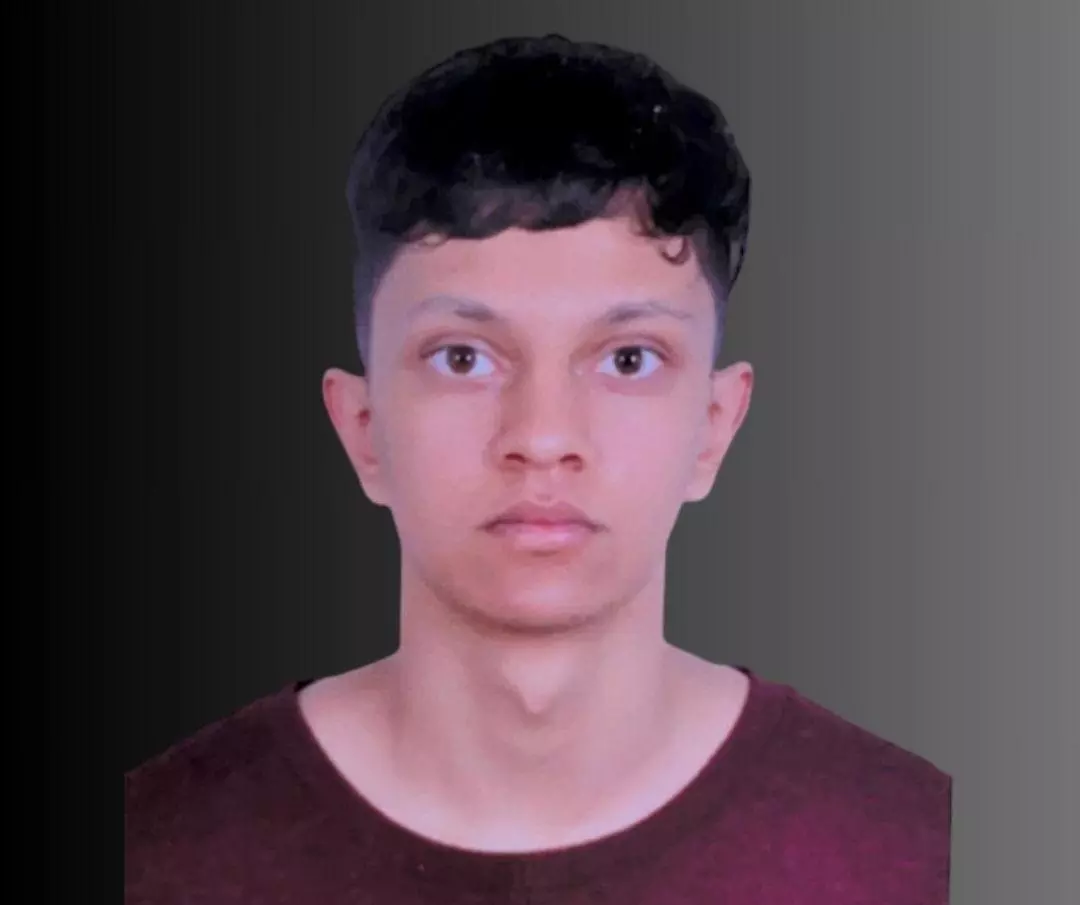Residual Limitation Provisions (Articles 113 & 137) | The Limitation Act, 1963
In situations lacking a specified time frame, the relevance of Article 113 and Article 137 of the Limitation Act 1963 emerges.

In situations lacking a specified time frame, the relevance of Article 113 and Article 137 of the Limitation Act 1963 emerges. Article 113 pertains to suits for which no specific period of limitation is provided elsewhere in the Act.
On the other hand, Article 137 deals with any other application for which no limitation period is specifically provided elsewhere in the Act.
Introduction
The function of conferring rights or the substantive aspect of laws/legislations is fundamental to a democratic polity/form of governance. Depending upon its ideals, values and form of governance, how rights are conferred and enforced/exercised vary amongst nations and result in certain inclusions and exclusions of rights of varying nature. However, how an infringement/violation of a right is remedied does not seem to meander so widely.
A sound legal system reinforces the protection of laws through active judicial involvement, allowing aggrieved parties to sit before Courts and seek the desired action against the opposite party. Each right (specific to India) is either statutorily or constitutionally accorded to the different classes of individuals, where citizens would enjoy certain added rights/privileges and non-citizens(immigrants, tourists) would not.
Thus, it may be seen that certain determining factors would decide the few ways in which rights may be restricted/limited or that a certain class of individuals may be deprived of them. A list of these determining factors would equate to a list of exceptions/circumstances in which an individual may lose the capacity to enforce his rights. Similarly, rights can also be extinguished. Such an act may not depend upon an omission or commission but very well depends on action/in-action.
In light of the said context, the Limitation Act, 1963 (hereinafter referred to as the Act) is one such Indian legislation that exhaustively defines the different statutory temporal restrictions while enforcing a wide variety of rights through the institution of suits before a Court of Law. The Act contains 32 sections and a Schedule containing 137 Articles distributed amongst 10 parts.
The Act contains a Schedule attached to it which is the component of the legislation within which the actual limitations are prescribed/enunciated. This Schedule has 137 Articles elaborating the different types of suits that may be instituted depending upon the relationship between parties, the nature of rights and duties of parties and other such components.
1. Article 113 of the Limitation Act
- Titled - ‘Suits for which there is no prescribed period'
Article 113 of the Limitation Act addresses the time limitations for legal actions not explicitly covered elsewhere in the legislation. It acts as a comprehensive provision, determining the timeframe for suits without a specified limitation period. This Article establishes a broad guideline, stipulating that such suits must be initiated within three years from the date when the right to sue arises. However, it's crucial to consider the unique details of each case, as the commencement of the right to sue may vary. Article 113 aims to set a reasonable timeframe for commencing legal proceedings in situations where other provisions lack specificity.
It's a kind of safeguard which steps in when other rules are vague, setting a fair timeframe for legal moves. Articles 113 and 137 have often been regarded as a timekeeper, making sure everyone adheres to these legal provisions.
Article 113 distinguished from Article 58 which contains the additional word “first” between the words “sue” and “accrues” and also held that accrual of the right to sue under Article 113 of the Schedule of the Limitation Act, 1963 (the Act) did not necessarily arise when the right to sue first accrued but rather when there was a clear and unequivocal threat of infringement of rights.- Shakti Bhog Food Industries Ltd. v. Central Bank of India, (2020) 17 SCC 260.
In State of Punjab v. Gurdev Singh, (1991) 4 SCC 1, the Court pondered upon Article 113 and its different interpretations, primarily focusing on the terms ‘when the right to sue accrues’. In this case, the Court declared that Article 113 is residuary for cases not covered by any other provisions in the Act. It prescribes three years when the right to sue accrues.
Under Article 120 it was six years which has been reduced to three years under Article 113. According to the third column in Article 113, time commences to run when the right to sue accrues. The words "right to sue" ordinarily mean the right to seek relief using legal proceedings. Generally, the right to sue accrues only when the cause of action arises, that is, the right to prosecute to obtain relief by legal means.
Article 58 of the Schedule which deals with the Limitation period w.r.t obtaining any declaration, sets the said period as 3 years from the time at which the right to sue ‘first’ accrues. The use of the term ‘first’ over here is of significant importance and has been previously compared to Article 120 (now Article 113) of the same Schedule for the difference in language used. This would imply that how the limitation period is interpreted differs fundamentally.
Right to sue first.—While enacting Article 58 of the 1963 Act, the legislature has designedly departed from the language of Article 120 of the 1908 Act. The word “first” has been used between the words “sue” and “accrued”. Impact of the word “first”, explained, (L.C Hanumanthappa v. H.B Shivakumar, Civil Appeal No. 6595 of 2015).
2. Article 137 of the Limitation Act
- This Article is titled ‘Any other application for which no period of limitation is provided elsewhere in this Division’ and has been accorded a Limitation period of 3 years from the time at which the ‘right to apply accrues.
This Article is also a component of the Residuary Limitation aspect of the current Law, allowing for slight ambiguity to provide for better flexibility in application. Since it has such a broad scope, it can be applied, although only within the limits of the law, to meet ends w.r.t determining the period of Limitation for any suit, application or declaration which has not been expressly provided for by the Act.
To draw an example with the judicial pronouncement, it is observed how the said Article has been used w.r.t different legal circumstances. In Sameer Kapoor and another v. State through SubDivision Magistrate, (2020) 12 SCC 480, it was held that this Article applies to an application for a grant of probate and letters of administration, including under Section 228 of the Succession Act, 1925 and that the Right to get letters of administration is a continuous right which can be exercised at any time so long right survives.
Article 137 of the Limitation Act, of 1963, is a key provision governing the filing of applications to courts when no specific period is stipulated elsewhere in the Act. It serves as a general catch-all provision, offering a broader window of time for legal actions. Article 137 acts as a safety net, offering litigants the opportunity to seek justice within a specified timeframe for matters not covered elsewhere in the Act.
In M. Joshi v. Life Insurance Corporation of India, (1969) 2 SCJ 749, the Supreme Court held that
Article 137 of the Limitation Act, 1963, contemplates only applications to courts and the scheme of the Act is, that it deals only with applications to courts, and the Labour court is not a 'court' within the Limitation Act, 1963.
In the case of Ajaib Singh v. Sirhind Cooperative Marketing-cum-Processing Service Society Ltd., AIR 1999 SC 135, the appellant was a salesman with the said company, and his service was terminated on July 16th, 1974. For almost 7 years after such termination, there was inaction by the plaintiff, after which he filed a complaint with the Labour Court, which then passed a verdict in favour of the aggrieved in 1986. The opposite party then filed an appeal before the relevant High Court which set aside the decision of the Labour Court. Therefore, an appeal was filed in the apex court against such a decision. The apex court in the instant matter observed:
The provisions of Article 137 of the Limitation Act, 1963 do not apply to the proceedings under the Industrial Disputes Act, 1947. Also, relief under this Act cannot be denied to the workman just because there was a delay in raising the industrial dispute.
Conclusion
The decisions clarify that limitations for Articles 113 and 137 would start running when there is an unequivocal threat to one’s rights and not merely when the breach happened. In other words, it is when there is a threat to redressal of the breach that the right to sue/apply arises. The decisions affirm that courts should not mechanically calculate limitations based solely on when the breach occurs.
Reference
[1] The Limitation Act, 1963, Available Here

